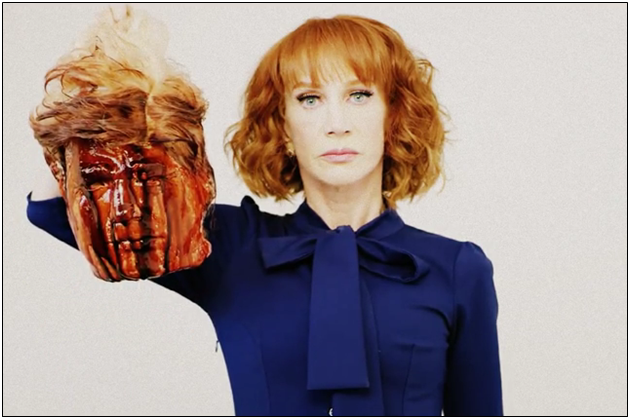By Natalia Castro
Kathy Griffin’s imaginary execution of President Donald Trump was “only a joke” but the fear it incited in 11-year-old Barron Trump was anything but funny. As both sides of the aisle condemn Griffin’s actions, this incident serves as a reminder that political violence cannot be accepted — for, in order for liberty to prosper, it becomes a civil duty to reject it when it is popularized in this manner.
Although it might incite a Secret Service investigation, Griffin’s joking beheading of President Trump was likely not illegal. It is well within her First Amendment rights to make such an offensive joke. But her freedoms should not allow society to socially embrace this action, as the implications of political violence are far too great — and dangerous.
Throughout history it is clear that when society begins to accept violence against political opponents as the norm, not just rejecting others opinions but their lives entirely, undemocratic regimes are easily able to gain control.
During the French Revolution, political violence was seen as a necessity to dismantle oppressive power structures, but consistently, rulers attaining power through violent means were subject to the same violence.
As historian David Andress explained at the a keynote to the conference, ‘Living in Violent Times’, University of Warwick in 2013, “The revolutionaries of the 1790s were convinced that they were working against violence. Even Jean-Paul Marat, the journalist whose unambiguous calls for the execution of traitors alienated almost every other political leader, always framed those calls in the context of an active threat of counter-revolution, plotting to restore tyranny by force, and as a prophylactic against greater massacre — hundreds of heads should fall, to save tens of thousands.”
British philosopher, Edmund Burke, theorized in 1790 that the reckless revolution in France would ultimately lead to tyranny. France experienced over a decade of public rioting, political executions, and popular discontent. The country did not have a stable leader until 1799 when a military coup d’etat abolished the executive leaders appointed by parliament and thrust Napoleon Bonaparte into power.
Thus, through the normalization of political violence, France allowed unfettered freedom to dehumanize opposition parties and thus experienced a tumble of increasingly radicalized leaders.As Burke warned, “what is liberty without wisdom, and without virtue? It is the greatest of all possible evils; for it is folly, vice, and madness, without tuition or restraint.”
In a more recent example of normalized political violence, the Russian Revolution, Mao’s Cultural Revolution and even the Roman civil wars of antiquity all stand out as other prominent, historical examples of how the destruction of political opponents ultimately resulted in tyranny.
The German and Italian fascists of the early 20th century dehumanized their enemy as well. Germany experienced a period of increased political violence from 1918 to 1933, when the public was left discontent after the first World War. In a similar effort to promote revolution in the nation, German citizens began attacking opposition leaders and holding political rallies that nearly always broke out into violent brawls. The result was eventually a banning of all opposition political parties and the establishment of a Nazi totalitarian state.
In Italy, Fascist violence was used to break the threat of socialism. “Blackshirts” traveled to small towns throughout the Italy and forced political opponents to drink castor oil, before stripping them naked and beating them.
This political violence was justified because the opponent’s ideas made them less than human and therefore, able to be destroyed. Micheal Ebner of Slate Media notes, “Through illegal violence, rather than elections, Fascists controlled government administration and destroyed the offices, newspapers, and cultural and social organizations of the Socialists, trade unions, and peasant leagues. Mussolini occasionally decried the illegal activities…but they operated as the motor that drove his government along the road to dictatorship.”
Even in our own country nearly 100 years later, we must remember the threat of such revolutionary violence.
The most prominent current example is inherent in the Islamist, terrorist message in the United States, following the 2009 shooting at Fort Hood, domestic terrorist Nidal Malik Hasan requested to be a full citizen of the terrorist organization Islamic State, claiming he believed in the establishment of a Muslim caliphate government ruled by fundamentalists.
This sentiment has been mirrored from the Orlando Pulse Night Club shooting to San Bernardino, violence to pursue a political objective is alive and well in the United States. As radical jihadists pursue their own political agenda, American lives are increasingly being placed at risk.
These may seem like extreme examples, but similar sentiment is seeping into the political mainstream. Just this past April, a clash between pro-Trump and anti-Trump protestors led to 21 arrests, 11 injuries, and seven hospital transports for students at Berkley University. A political rally, that quickly turned to political violence — and serve as a warning that it can always get worse.
Kathy Griffin has been fired from CNN and publicly apologized, but her statement calling for the beheading of President Trump was not merely deplorable — it represents a threat to liberty and the constitutional rule of law.
So far, in most domestic cases of political violence public authorities have responded adequately. But as a civil society we must remember that Griffin’s act is not a joke when public beheadings are a trend for Islamic State already overseas. The rejection of political violence is integral to preserving that civil society, and protecting our democracy against tyranny.
Natalia Castro is a contributing editor at Americans for Limited Government.







